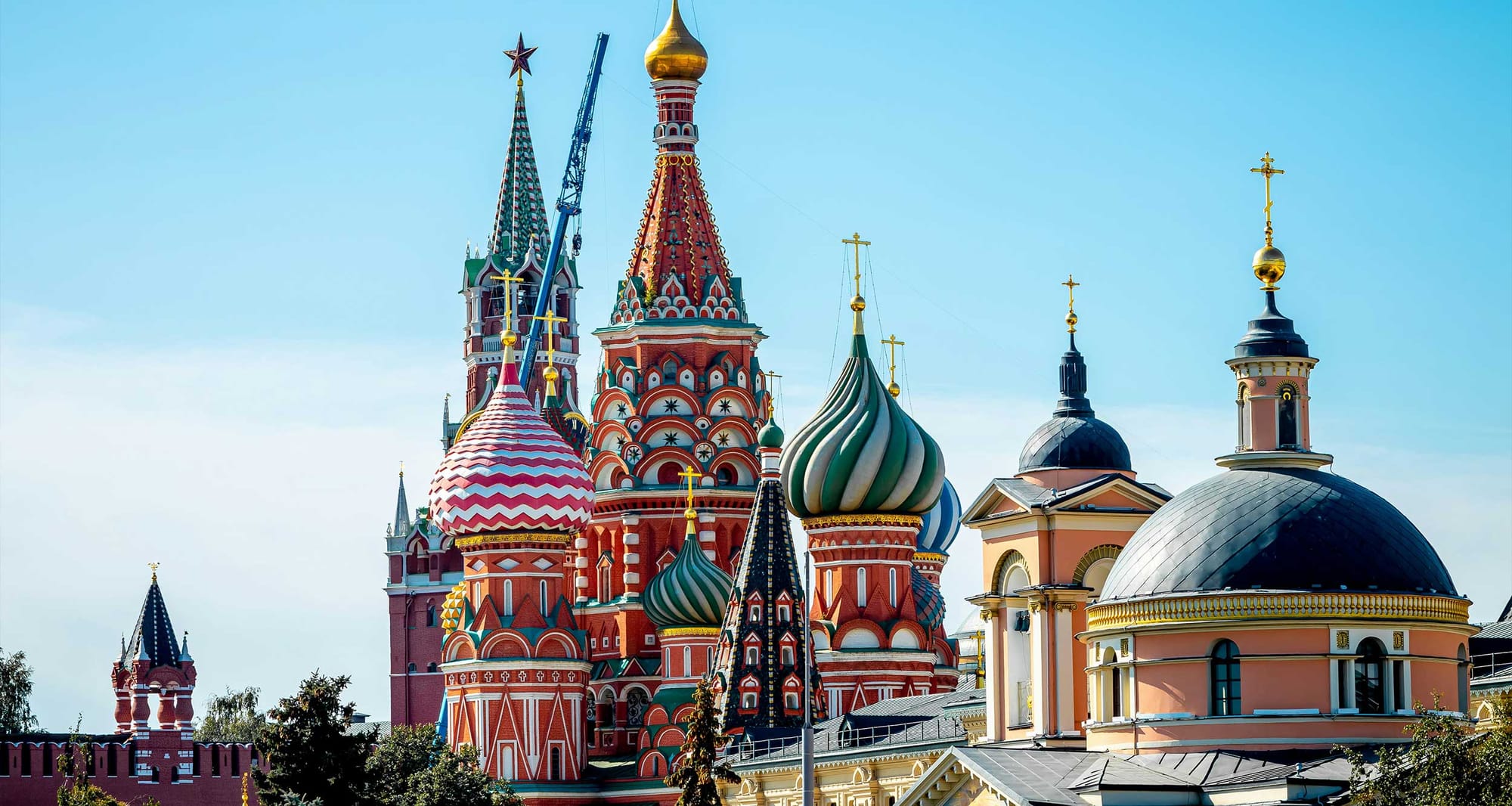
Moscow is an Eastern European city with a long history that has long struck my own curiosity. I’m excited to share the things I was able to see and do during my visits to Moscow, because it was truly an incredible experience.
As I’m sure you can imagine, the attractions in Moscow don’t feature the same level of accessibility as I’m used to in the United States. But that doesn’t mean tourism in Moscow is a lost cause for the wheelchair user. While the Kremlin and Red Square can be accessed, few of the buildings within are barrier-free. Despite the restrictions at some sights, others such as the historic Bolshoi Theatre and the Cathedral of Christ the Savior are accessible without difficulty. As I always say, you may be forced to adapt from the norm to participate in certain experiences, but it is possible to enjoy a trip to the City of Moscow with some advance planning. With this guide, I hope you’ll be able to make the most of your time in this incredible Russian city.
The Kremlin
The Moscow Kremlin is one of a number of such citadels in Russia, and is the residence of the President of the Russian Federation. The word Kremlin, meaning “fortress inside a city,” has become known as the Moscow compound which is comprised of five palaces, four cathedrals of the Eastern Orthodox Church, an armory, and the enclosing Kremlin wall and towers. The central public space within the Kremlin walls is Cathedral Square.
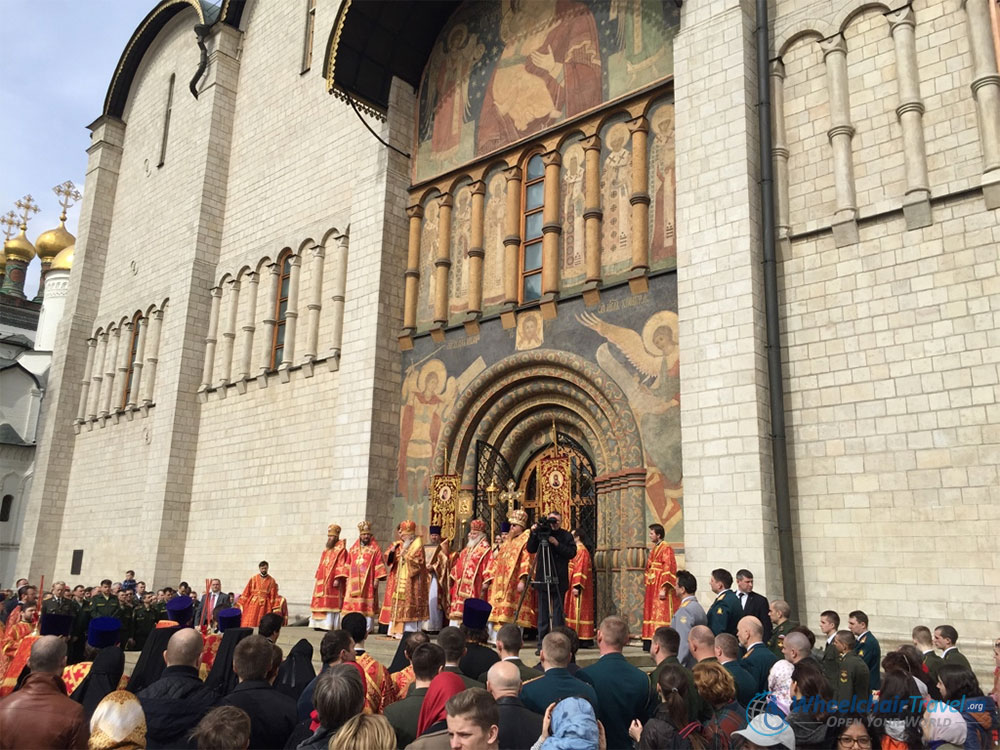
The Cathedral of the Dormition, Cathedral of the Archangel and Cathedral of the Annunciation all sit on this square. The tallest structure on the square is the Ivan the Great Bell Tower. Cathedral Square has played an important role in Russian history, as it has been the site of the coronations and funeral processions of all Russian stars, patriarchs, Grand Dukes and, more recently, presidents. Wheelchair users are able to enter the Kremlin, see across its walls and down at the Moskva River, cross the Troitskiy Most (a bridge), walk up to the enormous Tsar Bell and stand in Cathedral Square. The individual cathedrals, however, do not have access ramps for wheelchair users. The Armory within the Kremlin is accessible inside, but you and your chair will need to be lifted up a few steps at the entrance. Tickets to the Kremlin grounds and for access to the cathedrals cost 500 RUB. An additional ticket of 700 RUB must be purchased for those wishing to enter the Armory Chamber and Museum. Tickets can be purchased at the ticket booth in Alexander Gardens, and the Kremlin public entrance is at the Troitskiy Most bridge. Wheelchair users should be aware that the entrance pathway is paved with cobblestones. It is a rough ride, but passable. For more information on touring the Kremlin, visit kreml.ru.
Alexander Gardens
The Alexander Gardens, opened in 1823, sit along a one-half mile stretch of the western wall of the Kremlin. The park comprises three separate gardens, each with a unique offering of Russian historical installations and memorials.
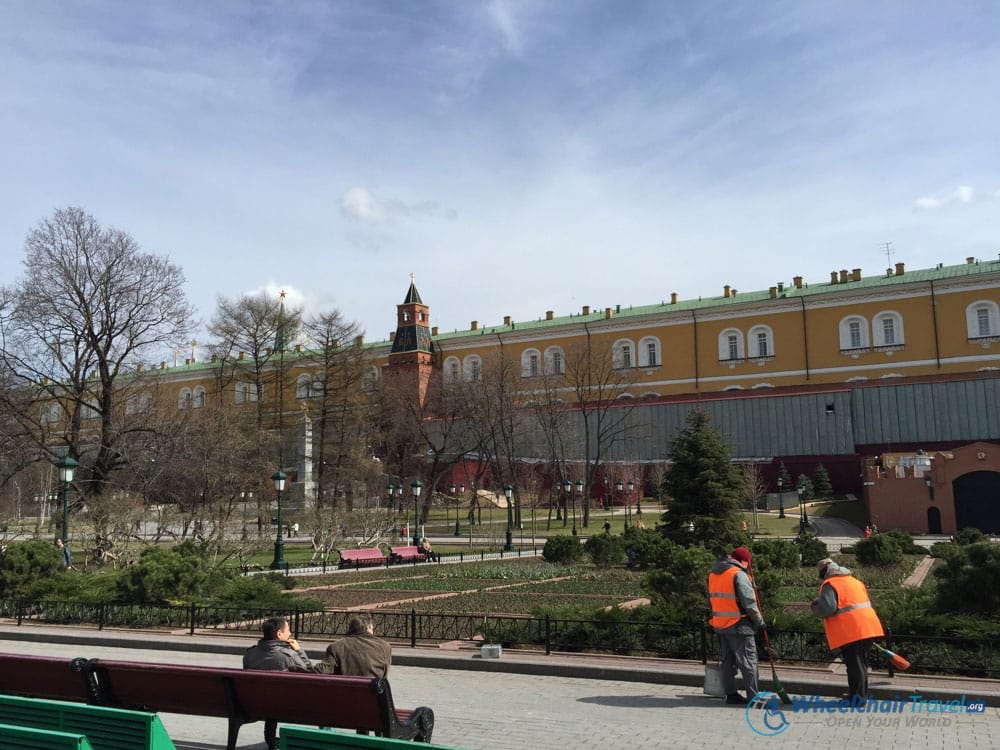
The park’s Upper Garden is home to Russia’s Tomb of the Unknown Soldier, which contains the body of a soldier who fell during the Great Patriotic War, World War II. An eternal flame has been burning at the tomb since its construction in 1967. Among the most popular attractions within the park is the Fountain of Horses by Tsereteli. The large fountain and water pool features four horse statues and numerous water features. The fountain is only in operation during the warmer months. Alexander Gardens is known for being well manicured and immaculately beautiful. The pathways throughout the park are accessible to wheelchairs without difficulty. The park is also home to the ticket booth for access to the interior of the Kremlin, and features a wheelchair accessible restroom facility. The park is open to the public year round.
Red Square
Designated a UNESCO World Heritage Site in 1990, Red Square is the center of Moscow. All of the city’s major streets originate at the square, which is bordered by the Kremlin, the GUM Shopping Center and the Alexander Gardens. Red Square is home to two of the city’s most popular sights, St. Basil’s Cathedral and the Mausoleum of Vladimir Lenin. The Square is also home to the Kazan Cathedral, which is wheelchair accessible via a steep ramp. Assistance will likely be required in navigating up or down the ramp. Entry into Red Square is free to everyone and there are no security checks required.
St. Basil’s Cathedral
Saint Basil’s Cathedral, officially the Cathedral of the Intercession of the Most Holy Theotokos on the Moat, sits at the end of Red Square. The cathedral may be the most recognized image of Russia for foreigners and tourists. Consecrated in July 1561, the cathedral was commissioned by Ivan the Terrible to commemorate the military victories in Kazan and Astrakhan.
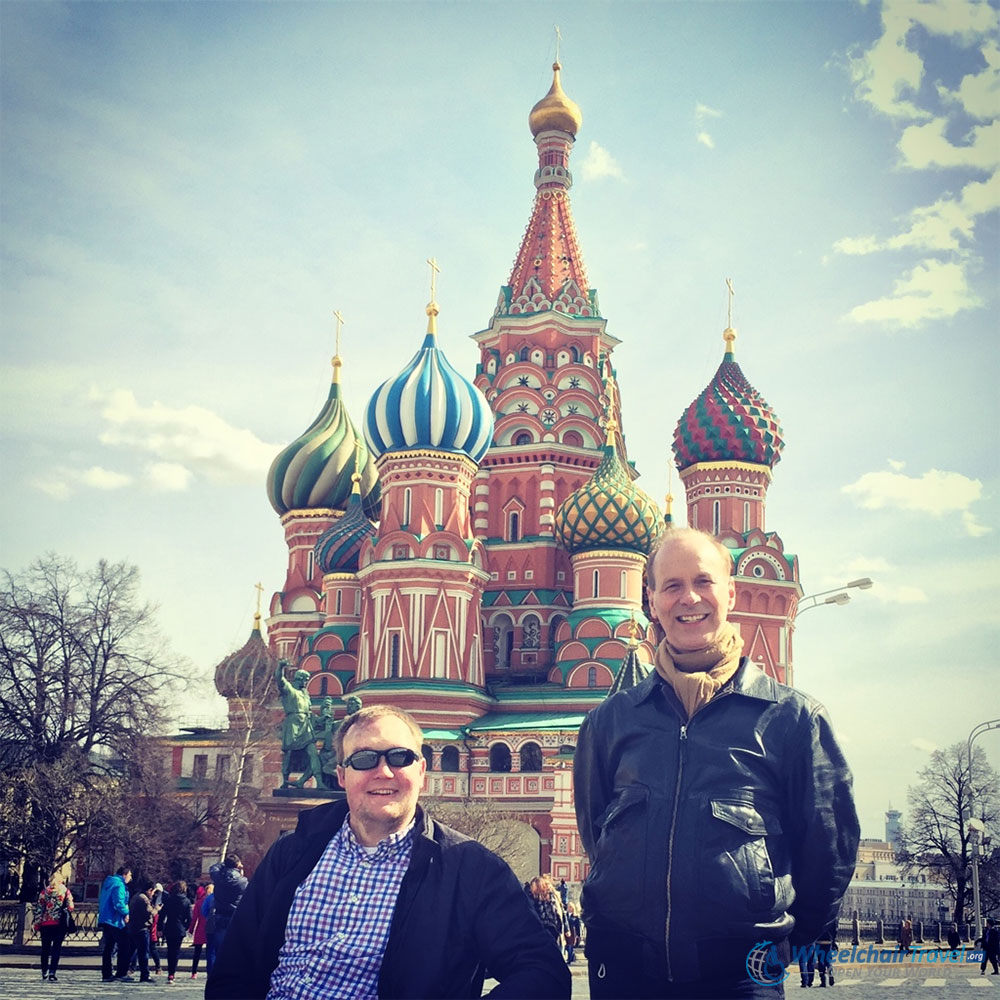
It is now referred to as St. Basil’s Cathedral because it was built overtop the grave of the local Saint, Vasily, or Basil. The building was designed to appear as though it were a flame rising to the sky. Its design sparked the following commentary from architectural writer Dmitry Shvidkovsky: “Nothing similar can be found in the entire millennium of Byzantine tradition from the fifth to fifteenth century … a strangeness that astonishes by its unexpectedness, complexity and dazzling interleaving of the manifold details of its design.” The cathedral does showcase a shocking, complex and almost wild design.
With the rise of Lenin and the creation of the socialist Soviet Union, St. Basil’s Cathedral was forcefully taken from the Russian Orthodox Church by the government. Since 1928, the cathedral has operated as a division of the State Historical Museum, property of the Russian Federation. There are no religious services held within the cathedral and it is now only a museum. The interior can only be accessed via stairs and is not wheelchair accessible. It would be possible to be carried in a manual wheelchair up the stairs. Unfortunately, I use a power wheelchair – bummer! For more information on St. Basil’s Cathedral, visit saintbasil.ru (in Russian).
GUM Shopping Center
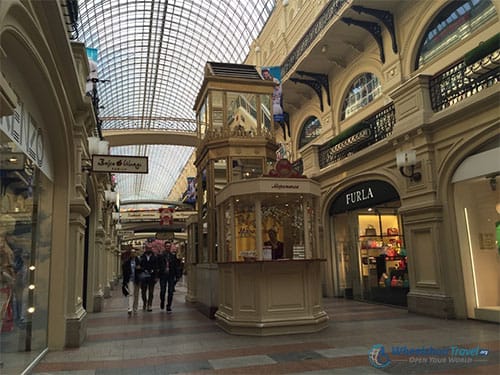
The GUM Department Store, or Main Universal Store, is the main department store in many cities of the former Soviet Union. The GUM in Moscow is the most famous of these stores, as it sits facing Red Square and the Kremlin. The shopping center, which features multiple levels and a glass roof, contains many luxury retailers, restaurants, cafes and coffee shops. Due to its proximity to the Kremlin and Red Square, it is visited frequently by both Russian and foreign tourists. GUM is fully accessible to wheelchair users, featuring elevators/lifts and ramps. Wheelchair accessible restroom facilities are available inside the mall. For more information on the Moscow GUM or for a list of retailers, visit gum.ru/en.
Bolshoi Theatre
The Bolshoi Theatre traces its history to 1776, when empress Catherine the Great permitted performances of theatre and ballet to be held within Moscow. The Bolshoi Theatre building, opened on the day of Tsar Alexander II’s coronation in 1856, is a historic venue for ballet and opera performances in Moscow.
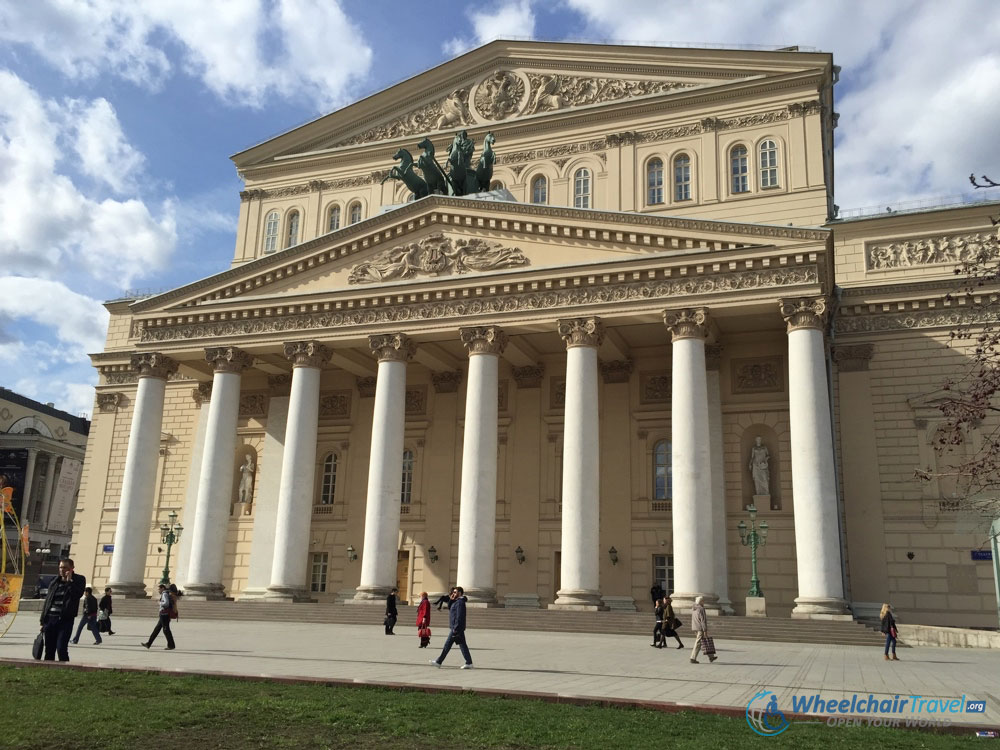
The theatre is the residence of the current Bolshoi Ballet and Bolshoi Opera companies. They are among the most celebrated opera and ballet organizations in the world. The ballet troupe is the world’s largest, with more than 200 dancers. The theatre building, designed by architect Joseph Bove, is an iconic landmark in Moscow. Most recently renovated in 2011 at a cost of more than $688 million, the theatre hosts ballet and opera performances almost daily. The theatre is wheelchair accessible, with space for six wheelchairs at the ballet’s Historic Stage and space for two at the Opera’s New Stage. These spaces should be reserved well in advance, as performances sell out quickly. The theatre ticket office’s staff does have some difficulty understanding English, so it may be best to have your hotel concierge or travel agent arrange for tickets in advance of your arrival to Moscow. Among the theatre’s most lauded performances are the Swan Lake and Don Quixote ballets, and the La Boheme opera. Tickets to performances range in price based on day, time and performance. Additional information on tickets, performance schedules and the theatre building is available at bolshoi.ru/en.
Cathedral of Christ the Saviour
Standing at 338 feet on the bank of the Moskva River, the Cathedral of Christ the Savior is the tallest Eastern Orthodox church in the world. Built in 2000, the building has a much longer history. The original cathedral built on the same site was consecrated in 1883, but later demolished by the Soviets in 1931 under the direction of Joseph Stalin. The original church was commissioned by Tsar Alexander I in 1812 in honor of Russia’s victory over Napoleon and to memorialize the sacrifices of the Russian people. Nicholas I later succeeded to the throne and took over the project, relocating it to its current site, a few blocks from the Kremlin.
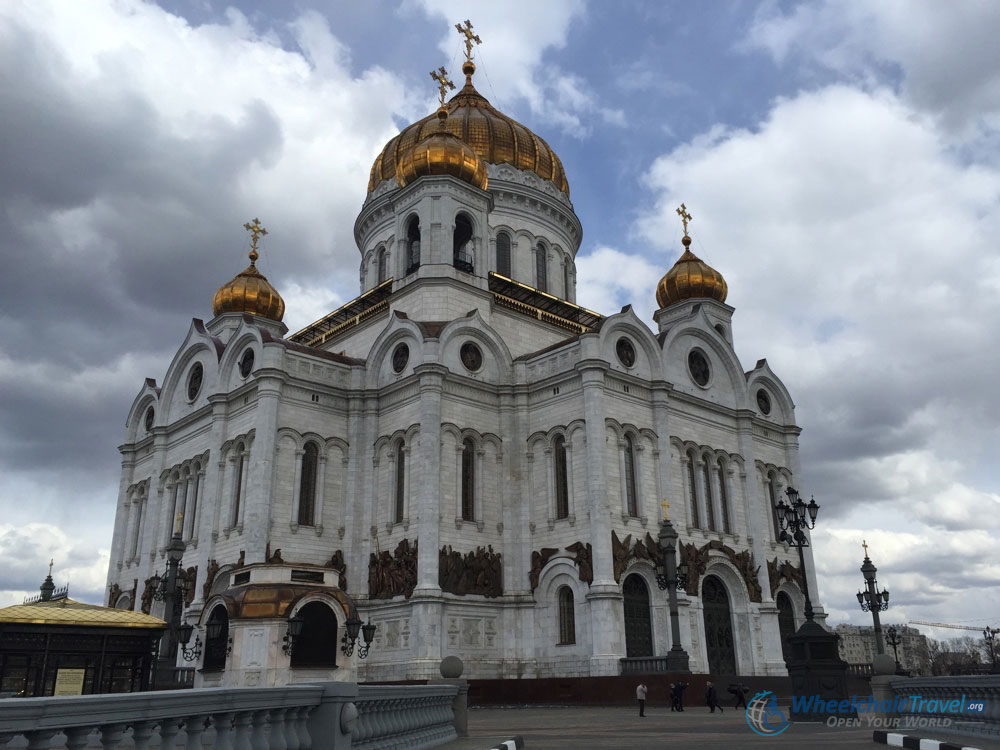
The cornerstone of the current, rebuilt structure was laid in 1990. The new church is a close replica of the former, but with some changes and modern improvements. Since its reconstruction, the church has served as the site of several major events and celebrations, including the canonization of the final Romanovs as saints, Tsar Nicholas II and his family. The cathedral is fully accessible to wheelchairs, via the entrance to the left of the church when looking from the Moskva River side. This entrance is located on Soymonovskiy Road. Church employees will escort persons with mobility difficulties to the elevators, which are behind secured doors. The cathedral is a place of worship for Christian Muscovites and is usually quite busy. The interior of the church features multiple levels and is immaculate in its beauty and design. Photography is not permitted within the sanctuary and chapels. Located close to the Kremlin, the church is also only one block from the Pushkin Museum of Fine Arts. For additional information on the Cathedral, visit the church’s official website at xxc.ru/english.
Old Arbat
Arbat Street, commonly referred to as the Old Arbat district, is a nearly one kilometer long pedestrian street in the historic center of Moscow. It is one of the oldest streets in the city, existing since the 15th century. Since the 18th century, wealthy aristocrats and merchants have made their home within the district. In recent years, the area has grown to attract younger Muscovites and tourists. It has become less a center of elite life and includes individuals from all economic segments and classes of the population. Arbat Street is now lined with bars, cafes, restaurants, souvenir shops, street artists and performers. The avenue is easily walkable and rollable, any many of the restaurants and cafes permit some level of wheelchair access. Harder to find, however, will be a business with an accessible restroom. The spotty accessibility within Old Arbat is due largely to the age of the buildings there. Still, it is a must-see for tourists and sure to make for an incredible Moscow memory.
Lubyanka (KGB) Headquarters
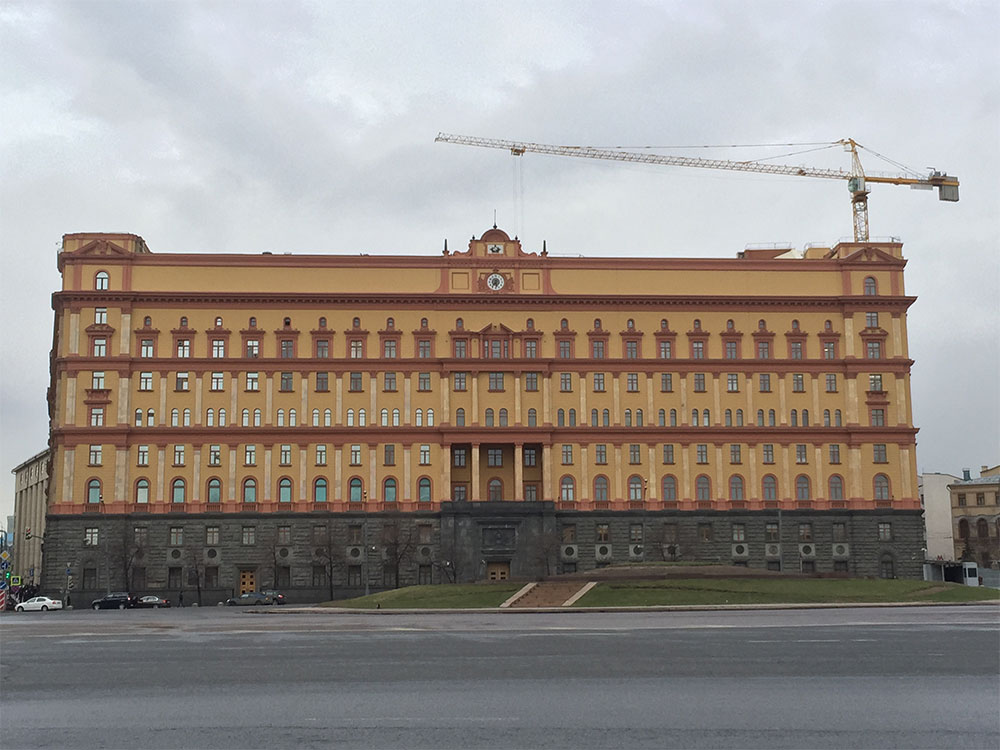
The Lubyanka Building, known for being the headquarters of the Soviet-era secret police, KGB, is now the headquarters of the Border Guard Service of Russia and one division of the Federal Security Service of the Russian Federation (FSB). A prison, located on the building’s ground floor, held many of the U.S.S.R.’s political enemies. Inmates were held, tortured and brutally interrogated there during the Soviet Union’s Great Purge of political dissidents. The prison within the Lubyanka Building is extensively detailed in Aleksandr Solzhenitsyn’s The Gulag Archipelago, a classic assessment of the U.S.S.R.’s history of torture and terror. A museum of the KGB, called the Historical-demonstration hall of the Russian FSB, has been opened to the public. I was unable to rate the accessibility of this museum during my April 2015 visit, as the museum was closed for renovation, with no advertised date of reopening. Please share your own experiences in the comments section at the bottom of the page. The Lubyanka Square provides a perfect place from which to photograph the building and is surrounded by a number of shops, including a wheelchair accessible shopping center directly across the traffic circle from the Lubyanka Building.
The Seven Sisters
The Seven Sisters, known locally as Vysotki or the Stalinist high-rises, are a collection of seven skyscrapers built between 1947 and 1953, in an attempt to modernize the Moscow skyline.
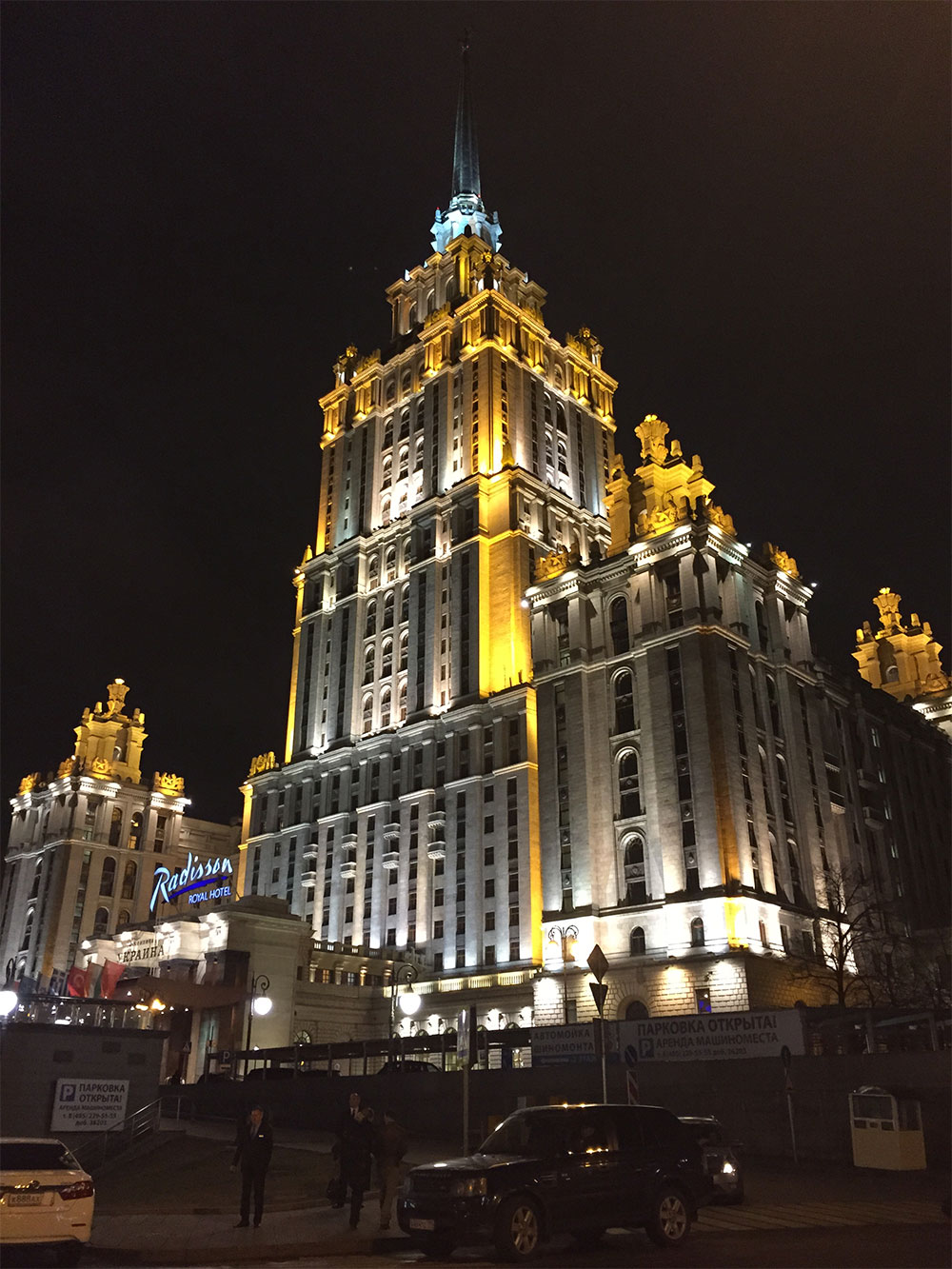
Nikita Kruschev recounted Stalin’s motivation, “We won the war … foreigners will come to Moscow, walk around, and there are no skyscrapers. If they compare Moscow to capitalist cities, it’s a moral blow to us.” The buildings remain today in their original Russian Baroque and Gothic styles, standing tall beautifully in the Moscow sky. The seven buildings are comprised of the following:
Hilton Moscow Leningradskaya Hotel
Hotel Ukraina – Radisson Royal Moscow
Kotelnicheskaya Embankment Building
Kudrinskaya Square Building
Ministry of Foreign Affairs
Moscow State University
Red Gates Administrative Building
I visited and stayed at the Radisson Royal Moscow Hotel, known as the Hotel Ukraina by Muscovites. The hotel is remarkable in its beauty, and has been updated to make it accessible to wheelchairs and those with other disabilities. Although I have not reviewed the remaining six sisters, photos suggest that they are equal in beauty. The purpose of the skyscrapers was to strengthen the world’s view of Moscow and the U.S.S.R., and little expense was spared to ensure that they rivaled buildings in the United States and Western Europe. For more information on the structures, consult this Wikipedia article.
Pushkin State Museum of Fine Arts
Named for Russian poet Alexander Pushkin, the Pushkin State Museum of Fine Arts features the largest collection of European Art in Moscow. Opened in 1912, construction of the museum’s main building began in 1898. The art collection is diverse, with pieces from all over Europe and galleries dedicated to French, German, Italian and Netherlandish Art. Additional galleries include Egyptian Art, Ancient Egyptian Art, and Art from Ancient Greece. Works on display include paintings, sculptures, textiles and more.
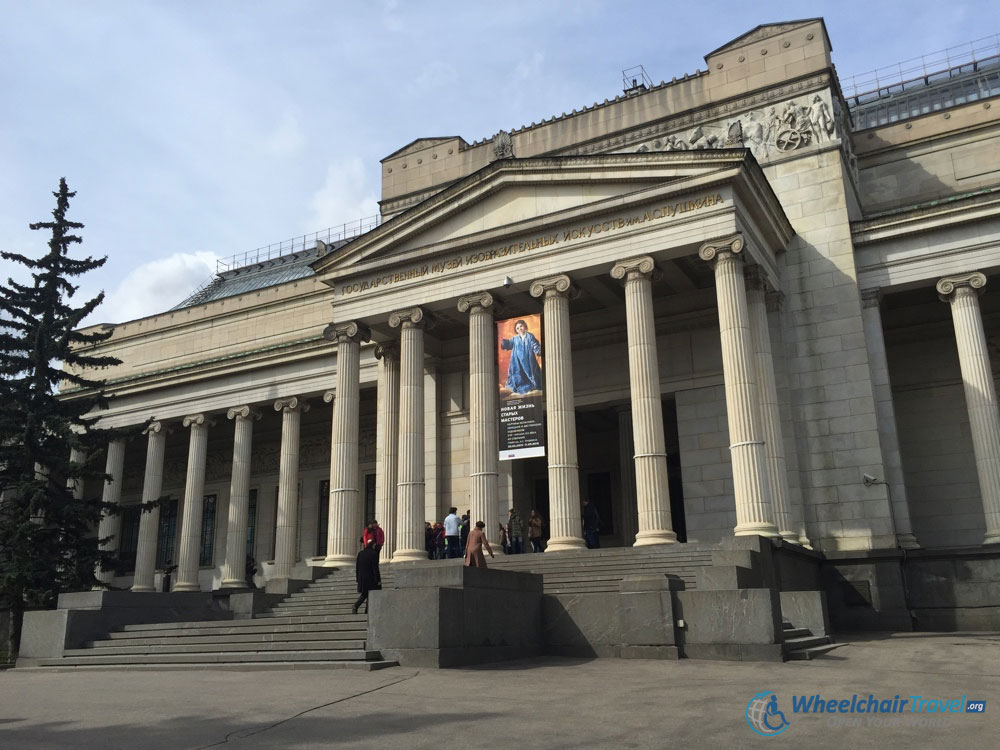
Although some websites claim that the Pushkin Museum is accessible, those bloggers clearly haven’t been to Moscow. To reach the exhibits and galleries on the ground floor, visitors must climb more than 20 steps. There is no ramp for wheelchair access. Museum employees are, however, happy to carry a wheelchair and its user up and down the steps to grant access to the museum.
Since I use a power wheelchair, I transferred into one of the museum’s loaner manual chairs and was carried up the stairs. I had a friend with me, who was able to push me around the galleries. There is no elevator to access the upper and lower floors of the museum. For access to the underground floor, wheelchair users can be lifted down three steps via the museum’s side entrance. Access to the top floor is not accessible by wheelchair, as there are approximately 1.5 floors of stairs that must be climbed. Being carried such a distance is not practical or safe. Admission to the museum is provided free of charge to persons with disabilities. Admission is otherwise 300 RUB for adults. Additional information on the museum and its collections is available at arts-museum.ru.
Gorky Park
The Gorky Central Park of Culture and Leisure is an amusement park located along the Moskva River in the center of Moscow. It first opened in 1928 and is today a cultural center attracting both residents and visitors alike. It sits on nearly 300 acres and provides exquisite views of the river and surrounding city. Green spaces, fountains, cafes and restaurants are spread throughout the park. Smooth pathways are available, updated following the park’s 2011 renovation. Access to the park is provided free of charge to all. The park is wheelchair accessible, with ramps at every stairway and a number of bathrooms to accommodate the disabled and wheelchair users. For additional information on the park and its attractions, visit park-gorkogo.ru/eng.
Moskva River Dinner Cruise
The Radisson Royal Hotel, or Hotel Ukraina, is located within one of the iconic Seven Sisters skyscrapers, on the bank of the Moskva River. The hotel operates multiple dinner cruises throughout the day and evening, departing from the Hotel Ukraina’s pier or from Gorky Park. The cruise lasts three hours and passes a number of Moscow’s most popular sights. Among these are Moscow State University, the Peter the Great monument, the Kremlin, Cathedral of Christ the Saviour and St. Basil’s Cathedral.
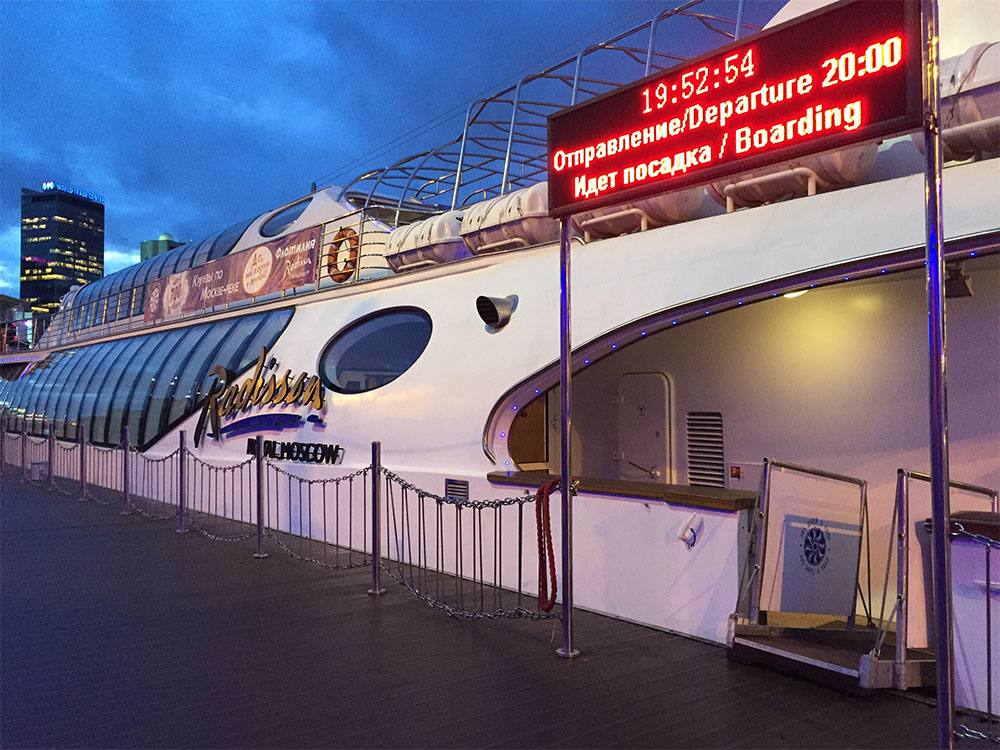
The evening cruise allows visitors to the see to see these sights lit up and from a different perspective out on the water. The cruise ships are wheelchair accessible, though the boarding ramp is not entirely level. Cruise staff will assist passengers in wheelchairs with crossing the barrier, even those in (extremely) heavy powered wheelchairs or scooters. Wheelchair passengers are unfortunately limited to the lower deck, but there is an outdoor viewing area at the ship’s stern. A wheelchair accessible (sort of) restroom facility is available onboard. Tickets for the lower deck cost 700 RUB. Dinner, drinks and dessert are available, but are not included with the cost of the ticket. The menu is reasonably priced and is a much better deal than many of the city’s restaurants. Each cruise ship returns to its point of departure and there are no stops through the journey. For more information on the cruise ships, route and departure times, visit radisson-cruise.ru.



